Worried your axolotl is getting too round for your preference? While it may seem cute at first and who knows, you might even make an instagram meme page called chonky axie, but being overweight can lead to serious health problems. So, what could be causing your aquatic friend to pack on the pounds?
To keep it brief, there are a few common reasons why axolotls may become overweight, including constipation, overfeeding, impaction, improper diet, and pregnancy.
Now, what can you do if you suspect your axolotl is carrying a few extra grams? In this article, we’ll dive deeper into the causes of axolotl obesity and provide tips on how to help your axolotl achieve a healthy weight. So, let’s jump in and get to the bottom of why your axolotl is getting fat.
5 Possible Reasons for Weight Gain in Axolotls with Solutions
As an axolotl owner, you want your pet to be healthy and happy. But, unwanted weight gaining can be a serious issue for your lovely pet. There are 5 possible reasons why your axolotl might be getting fat, and now, we’ll explore them in detail. So, let’s start.
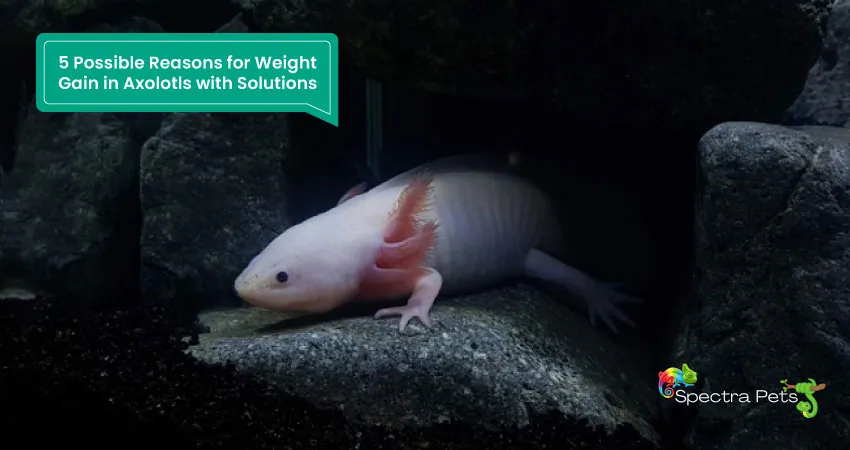
1. Constipation Problem
An adult healthy Axolotls usually takes food once every 2-3 days. The reason behind this is their slower metabolism compared to juvenile Axolotls, which requires more time to digest food thoroughly. On the other hand, juvenile Axolotls are known to consume one or two meals daily to fuel their rapid growth rate.
As they consume food daily, it’s natural for them to produce regular poop. In fact, they produce a significant amount of waste quite frequently. However, if an Axolotl doesn’t poop for two to three days, it’s likely experiencing constipation.
Constipation can cause several symptoms in Axolotls, including reduced energy levels, visible bloating, loss of appetite, and floating. This problem can arise due to several factors such as overfeeding or consuming improperly sized food.
Solution:
If the constipation is mild, allowing your Axolotl to fast for a while can help solve the problem. However, if the issue persists, placing the Axolotl in cooler-than-usual water for a couple of hours may be useful. It’s essential to monitor the amphibian to ensure that the water temperature doesn’t negatively affect its health.
If these steps don’t work, I recommend you seek veterinary assistance for your Axolotl. They can provide you with appropriate advice and medication to alleviate the constipation issue.
2. Impaction Problem
Impaction occurs when a massive and dense object blocks the intestinal passage of the axolotl’s body. Typically, impaction happens when an Axolotl consumes significant quantities of food or ingests gravel or small rocks.
When an Axolotl experiences impaction, the digestive system cannot process food and waste products correctly, leading to blockages and other complications. The Axolotl may appear sluggish, inactive, and uninterested in food, among other signs.
This problem can occur due to their feeding behavior, as they do not chew their food and instead use their mouths as suction devices to catch and swallow prey in one go. This makes it easy for objects to go down the wrong way, leading to impaction.
When an Axolotl experiences impaction, it will not be able to defecate, and its abdomen will rapidly inflate.
Solution:
Impaction is not likely to resolve on its own, and it’s crucial to seek veterinary assistance to prevent further complications. In severe cases, surgical intervention may be necessary to address the issue.
However, to prevent impaction in Axolotls, it’s essential to provide them with a well-balanced diet and remove any potential obstructions from their environment. Feeding them small, easily digestible pieces of food and keeping their aquarium clean and free of debris can also help to prevent impaction.
3. Pregnancy
Describing an Axolotl as “pregnant” is not an accurate term since they do not deliver a live young. Instead, the proper terminology to use is “gravid,” which refers to animals that carry eggs internally. Axolotls lay eggs as part of their reproductive process, so using the term “pregnant” to describe them is incorrect.
If an Axolotl female appears to be excessively bloated, it could be an indication that it is preparing to lay eggs. This is a natural aspect of their reproductive cycle, and pet owners who have experience with Axolotls should be well-versed with this process.
The mating phase of Axolotls typically lasts for several hours, during which there will be distinct interactions between the pair. As you become more familiar with your Axolotl’s behavior, you will be able to differentiate their mating behavior from their regular interactions. Once the mating is successful, the female will lay eggs within some days.
Solution:
If your Axolotls have mated, it is advisable to move the female to a nursing setup. To prevent the female Axolotls from becoming gravid and corpulent, it is advised that they are housed in solitude or alongside other females in the aquarium.
4. Bloating Problem
It is possible that your axolotl’s corpulence is not due to excessive adipose tissue, but rather it could be caused by the ingestion of an excessive amount of air. Axolotls also love to consume air bubbles while taking foods, which may lead to this condition.
Furthermore, excessive amounts of oxygen in the aquarium may also cause bloating in axolotls. It is crucial to assess the level of oxygen saturation in the water, as a saturation level of greater than 100% may not only lead to bloating, but also increase the risk of gas bubble disease.
Also, make sure the water pH level and temperature should suit your axolotl’s comfort level. Sometimes water quality and temperature lead to the bloating issue.
Solution
If you suspect that your axolotl is bloated, it’s important to identify the cause before taking any action. Bloating can be a symptom of various underlying health issues, such as digestive problems or bacterial infections.
Feeding your axolotl smaller portions and making sure they are fully submerged when feeding can help reduce the amount of air swallowed during feeding.
In case of excess oxygen in the water, it’s important to test the water regularly for oxygen levels and ensure the water quality is optimal. You can improve the water quality by increasing the water flow, cleaning properly, and adding live plants.
If your axolotl’s bloating persists or if you notice any other symptoms such as lethargy, loss of appetite, or abnormal behavior, it’s best to consult a veterinarian who specializes in aquatic animals for proper diagnosis and treatment.
5. Inappropriate feeding
Axolotls are prone to becoming overweight if they are not fed properly. This can occur due to overfeeding, feeding the wrong food, feeding too frequently, or feeding inappropriate portion sizes.
Moreover, overfeeding can lead to excessive weight gain because axolotls have a slow metabolism. Additionally, feeding them a diet that is high in fat or carbohydrates can also contribute to weight gain.
Solution
To prevent an axolotl from becoming overweight, it’s important to monitor their diet and feeding schedule. This aquatic animal requires a diet high in protein, so feeding them a balanced diet that includes the appropriate portions and frequency is crucial. Overall, proper feeding practices are key to maintaining the health and well-being of axolotls.
4 rare but alarming fattening reasons for axolotls that you need to be aware of
Let’s see some scary reasons for axolotl bloating. You need to take immediate action by discussing with an expert vet if you notice any of the following issues.
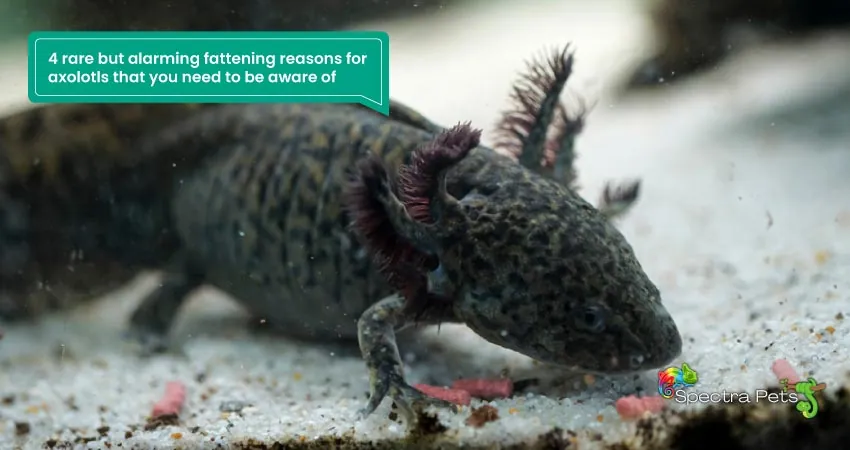
1. Parasitic or Bacterial Infection
Bacterial contagion poses an exceptionally dangerous threat to the axolotl. Exposure to the Aeromonas species of bacterial infection results in a sharp decline in the animal’s appetite and prompts rapid swelling, leading to fatal consequences in a matter of moments.
Co-occurring symptoms such as bleeding sores and inflammation of the limbs are often present. As the microbe infiltrates the axolotl’s body, it damages the vital organ systems, which causes a fluid imbalance.
Upon discovery of the ailment, treatment measures may be too late due to the severity of the internal damage. However, the timely detection and application of the appropriate medications could potentially reverse the condition.
2. Kidney Failure
Another rare but serious cause of axolotl bloating is kidney failure. Axolotls have sensitive kidneys that are responsible for filtering waste from their bodies. If the kidneys are not functioning properly, waste can accumulate and cause bloating.
In addition to bloating, axolotls with kidney failure may experience symptoms such as weight loss, lethargy, and abnormal behavior. Remember, Kidney failure is a serious condition that requires prompt medical attention from a veterinarian.
3. Short Toe Syndrome
Short Toe Syndrome is a genetic disorder that eventually leads to organ failure in axolotls. These creatures may look similar to dwarf axolotls, but the absence of elongated toes is a defining characteristic. As time passes, affected animals experience significant swelling throughout their entire bodies, and they may even suffer from hemorrhages.
Regrettably, there is no cure for this condition, and it is recommended that animals suffering from Short Toe Syndrome be humanely euthanized to end their suffering.
4. Thyroid Disorder
The thyroid gland in axolotls plays a pivotal role in maintaining their fluid balance. It produces hormones that regulate metabolism and growth. Any malfunctioning in this gland can lead to fluid retention and subsequent bloat. It is therefore advised to seek professional assistance from a veterinarian if your axolotl displays signs of a thyroid disorder.
What does a healthy axolotl look like?
A healthy axolotl typically has clear, smooth skin with a shiny, slimy coat. Its gills should be moderately sized and laid flat against its body, without any signs of discoloration, lesions, or excessive mucus.
Moreover, its body should be plump, but not overly bloated, with a firm texture to the touch. Its tail should be straight and symmetrical, with no signs of kinks, twists, or deformities.
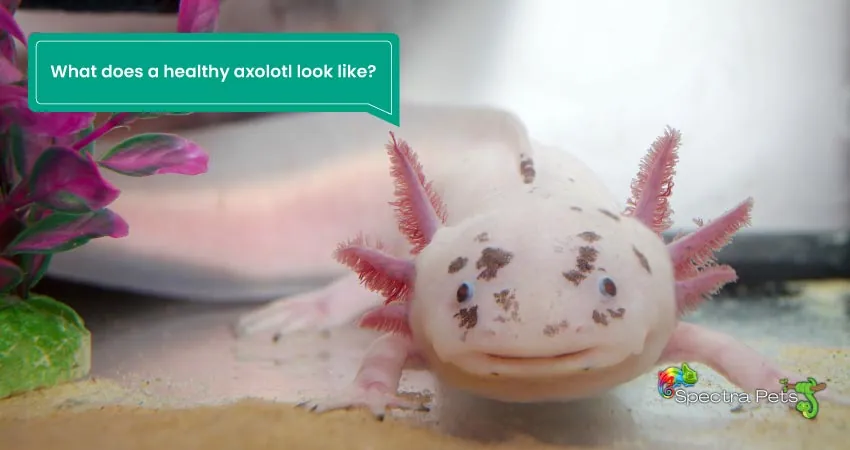
Additionally, your axolotl should be active and alert, able to swim and move around its tank without difficulty, and should exhibit a healthy appetite for food. Its eyes should be clear and bright without any signs of swelling.
Overall, a healthy axolotl should appear vibrant, lively, and well-cared for, with no visible signs of stress, illness, or injury.
Is Being Fat Bad for Axolotls?
Yes, it can be bad for an axolotl to be fat. Being overweight or obese can lead to various health issues in axolotls, just as it can in other animals and humans.
Some of the potential health problems that can arise from obesity in axolotls include decreased mobility, kidney problems, respiratory difficulties, and a weakened immune system.
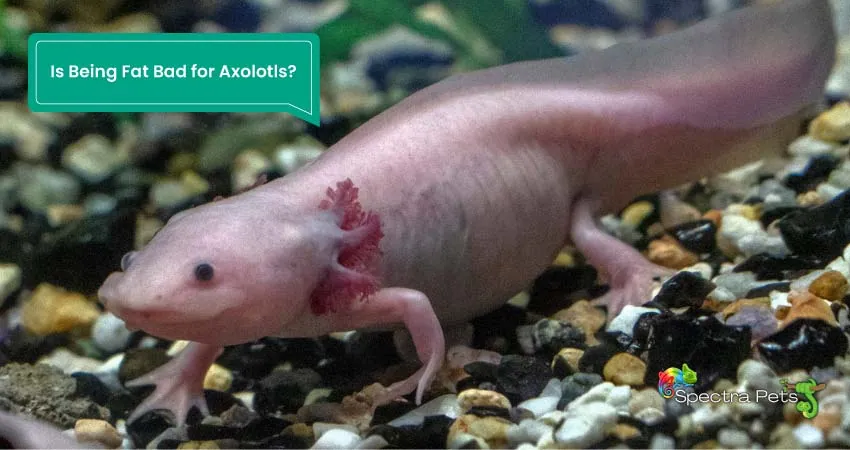
If you are concerned about your axolotl’s weight, you should consult a veterinarian who is experienced in treating amphibians. They can help you determine whether your axolotl is at a healthy weight and provide advice on how to help them maintain a healthy body condition.
How Much Should An Axolotl Weigh, and How Big Should It Be?
A healthy weight and size for an adult axolotl is typically around 8-10 inches in length and weighs between 60 and 300 grams. Females may be slightly heavier than males, but not necessarily longer.
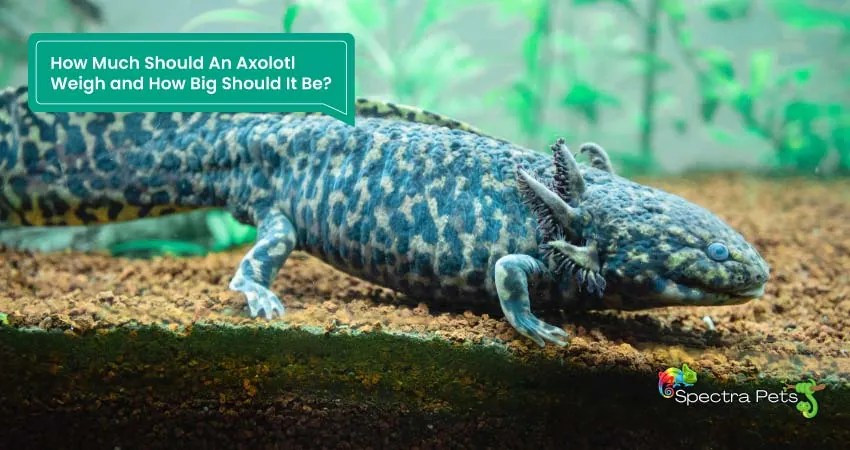
How to Prevent Weight Gain in Axolotls?
To prevent weight gain in your axolotl, it’s important to provide proper care and attention. Here are some tips to keep in mind:
- Feed your axolotl the right amount and type of food. Offer a variety of high-protein, low-fat foods that are easy to digest.
- Keep the tank clean and maintain good water quality. This will help prevent the accumulation of waste and the growth of harmful bacteria.
- Provide enough space for your axolotl to swim and explore. Axolotls are active creatures and need room to move around.
- Monitor your axolotl’s weight regularly. If you notice any sudden changes in weight or other concerning symptoms, seek advice from a veterinarian or experienced axolotl keeper.
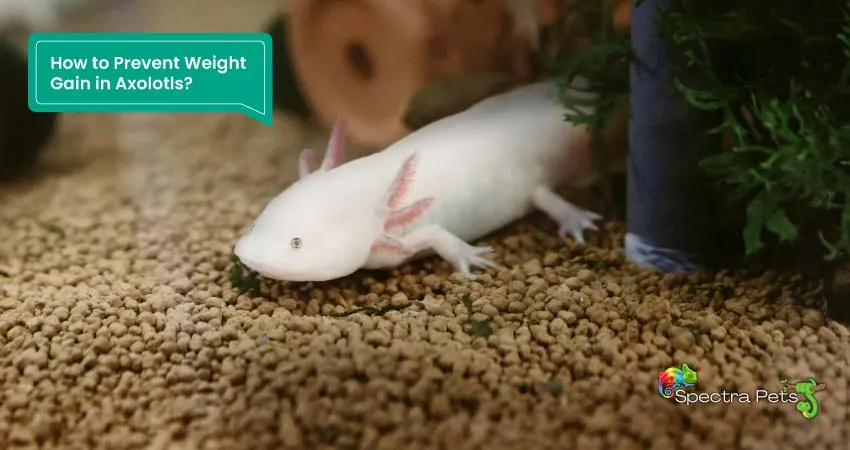
Conclusion
To sum up, there are several reasons why your axolotl might be getting fat. Constipation, impaction, improper feeding, pregnancy, and even disease can all contribute to obesity in axolotls.
As responsible pet owners, it is important to regularly monitor the weight and body condition of our axolotls and ensure they are physically fit. If you suspect your axolotl is overweight or have concerns about their health, seek advice from a qualified amphibian veterinarian. I believe, taking care of our axolotls properly can help them stay healthy and live a long, happy life.
